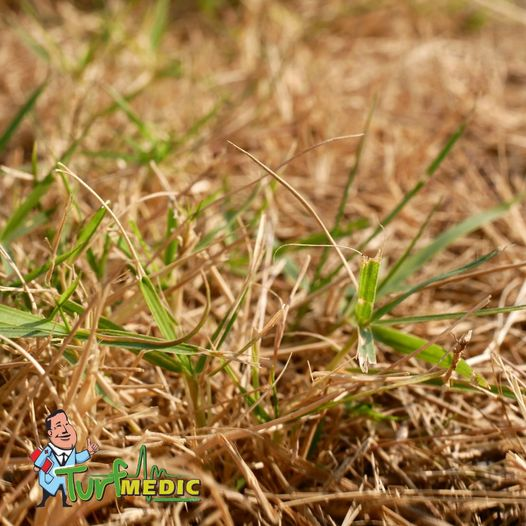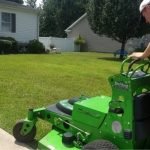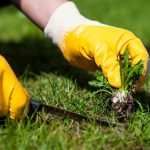During the winter your lawn is greatly affected by the elements. When the cool temperatures arrive, many homeowners start to notice their lawns turning brown. Just like any other species, grass plants must adapt to survive. When the winter hits, your grass doesn’t die, but it does become dormant (essentially goes to sleep!) to preserve scarce resources. Dormancy is a natural part of the turf growth cycle. Come spring, your grass will be back to its former vibrancy.
- Clear leaves and ornaments.
- Limit foot traffic.
- Only cut when necessary.
Lawn care year round is important for a beautiful lawn. Contact Turf Medics to set up an appointment for lawn care services.
Why Choose Turf Medic During The Winter For Your Lawn?
Turf Medic has the expertise and experience to keep your lawn looking beautiful even during winter. We understand that the cold weather can take its toll on your grass, leaving it brown, patchy, and weak. But with Turf Medic’s top-of-the-line treatments, you can protect your lawn from those harsh conditions and maintain a lush green lawn year-round.
Our team of lawn care specialists have extensive knowledge in diagnosing and treating your grass to ensure it stays healthy and vibrant during the coldest months. We use top quality fertilizers, weed control agents, and insecticides to keep your turf looking its very best. Our experienced technicians also take into account the local climate conditions when providing treatments for your lawn, so that no matter where you reside, Turf Medic has the perfect solution for you.
By choosing Turf Medic to care for your winter turf, you are guaranteed that your lawn will stay in tiptop shape throughout the season and be ready for a beautiful spring. With our experienced and knowledgeable professionals on board, rest assured that even during the coldest of winters, your grass will thrive under our care.
So don’t let winter get you down—choose Turf Medic and enjoy a vibrant lawn all year round! Contact us today to find out more about our services and how we can help you keep your grass looking healthy and green during the winter!
How To Prepare Your Lawn For Winter Season
It’s important to start preparing your lawn for winter before the cold weather hits. Taking a few simple steps now will ensure that your grass stays healthy during the cooler months and grows lush and green come springtime. Here are some tips on how to prepare your lawn for winter season:
- Clean Up Debris
A key component to preparing your lawn for winter is to clean up any debris that has accumulated over the summer. This includes leaves, twigs, sticks and other materials that can block sunlight or suffocate grass. Make sure you take away any debris from the lawn so it’s ready for a fresh start come springtime.
- Fertilizing The Soil
Fertilizing the soil with a winter-specific fertilizer can help your lawn grow healthier and stronger during the cold months. Be sure to choose a fertilizer that is designed for winter use and apply it according to package instructions.
- Aerate The Lawn
Aeration can help improve air and water flow to the roots of your grass, which will help it survive winter weather. With an aerator, you can loosen the soil and give roots more room to spread out. It’s best to do this a few weeks before the cold weather hits so that your lawn has plenty of time to adjust before temperatures drop significantly.
- Mow The Lawn Low
When preparing your lawn for winter, it’s important to mow the grass low. This will help protect the roots from any frost or snow that may settle into the lawn over wintertime. Be sure to use a sharp blade on your mower so that you don’t damage the grass and trim as close as possible without scalping the turf.
- Water Deeply
Giving your lawn a deep water before winter sets in can help ensure that the grass is healthy and strong. Make sure you water as deeply as possible so that the roots get enough moisture to last throughout the colder months. This will also help protect against any drought damage during the winter season.
- Cover Bare Patches Of Grass
If you have any bare patches of grass in your lawn, it’s important to cover them up with a thick layer of mulch or straw. This will help keep weeds at bay and protect the soil from cold temperatures. Make sure you don’t use too much, though—you want just enough to cover the area without smothering the existing grass.
These are just a few of the steps you should take when preparing your lawn for the winter season. Taking the time to do these simple tasks now will help ensure that your grass is healthy and vibrant come springtime!
Reasons To Aerate The Soil In Winter
Winter is a great time to aerate your lawn. Aerating the soil helps improve the drainage of water from your lawn, which can be beneficial in areas that get heavy rainfall or snowfall during winter. It also helps loosen compacted soils, allowing more air and nutrients to reach the roots of grasses and other plants.
Here are some of the other benefits of aerating your soil in winter:
- Enhancing root growth and development: Loosening the soil helps roots spread out more easily, allowing them to take up more nutrients and water. This helps improve overall grass health, as well as its ability to withstand cold temperatures during winter.
- Preventing disease and pests: Aerating the soil helps reduce the risk of diseases and pests, which can be a problem in winter when plants are trying to survive.
- Reducing compaction: Winter rains can lead to compacted soil, which limits grass growth and root development. Aerating helps break up these compacted soils, allowing more oxygen to get down to the roots for better health.
These are just some of the reasons why aerating your soil in winter is a great idea. It helps prevent disease and pests, improve root growth and development, and reduce compaction of soils. So if you’re looking for ways to keep your lawn healthy during the cold months ahead, don’t forget to consider aerating your soil by contacting Turf Medic (https://turfmedic.com/).
Winter Weed Control – How To Identify And Treat Common Weeds During The Colder Months
Winter weather can cause a variety of issues for our lawns and gardens, including the presence of weeds. It’s important to identify and treat common winter weeds before they take over your yard!
Winter weeds are often identified by their small size, slow growth rate, and wide leaf shape. They typically sprout during frosty temperatures, but can be found in other cooler months as well. Some of the more common winter weeds include chickweed, purple deadnettle, and henbit.
The best way to prevent winter weed growth is to keep your lawn healthy by mowing regularly and providing it with enough water and nutrients. You can also use a pre-emergent herbicide to help prevent winter weeds from sprouting.
Once the weeds are established in your lawn, it’s important to treat them accordingly. You can use hand-weeding or a post-emergent herbicide to control and remove them. When using an herbicide, make sure you read and follow all instructions carefully, as some products may not be suitable for use on certain types of plants.
By identifying and treating winter weeds early, you can help keep your lawn looking its best during the colder months. With a little bit of care and attention, you can ensure that your lawn is healthy and weed-free for years to come!
For more information on winter weed control or how to identify specific winter weeds, contact Turf Medic today and enjoy the best of winter lawn.
Tips On Applying Fertilizer In Colder Temperatures
As the temperatures start to drop, you may be wondering how to keep your lawn healthy. Winter lawn care is especially important for ensuring that your grass has a strong foundation before the spring. One of the best ways to ensure a lush and beautiful lawn come springtime is by properly applying fertilizer in colder temperatures. Here are some tips on doing just that:
Test Soil pH
The cold weather can lead to an increase in soil acidity. This can have a negative effect on the health of your lawn, so it’s important to test your soil’s pH before applying fertilizer. This will help you determine how much fertilizer you need and also ensure that the nutrients are properly absorbed.
Opt For Slow Release Fertilizer
When applying fertilizer in cold temperatures, it’s important to opt for a slow release type. This type of fertilizer will break down over time and provide your lawn with the nutrients it needs without being too harsh on the grass. It’s also best to apply slow release fertilizers in autumn, as your lawn can benefit from the nutrients throughout the winter months.
Apply In Moderation
When applying fertilizer in colder temperatures, it’s important to do so in moderation. Too much fertilizer can lead to nutrient burn and damage your grass. Start with a light application of slow release fertilizer and wait a few weeks before adding more. This will give your grass time to absorb the nutrients and help you avoid over-fertilizing.
Water Regularly
Watering your lawn regularly is key for success with winter fertilizing. Make sure that you’re providing your lawn with enough water, as it will need it in order to properly absorb the fertilizer and stay healthy during the colder months.
By following these tips, you should be able to keep your lawn in great shape throughout the winter. With a few simple steps and Turf Medic’s help, you can ensure that your lawn is ready for spring!
- Lawn Fertilization Loudoun County
Guidelines On Mowing During Wintertime
Winter may seem like the time to take a break from mowing your lawn. But in fact, winter is an important time of year to keep up with regular maintenance and mowing. During the cold season, there are certain tips and tricks you can follow that will help ensure your lawn stays healthy and lush for years to come.
First, reduce the height of your mowing blade to one inch for winter. This helps protect the grass from drying out and prevents it from being damaged by freezing temperatures.
Second, be conscious of the outside temperature when mowing. Aim to mow when it is above 40 degrees Fahrenheit and avoid mowing when the ground is wet from snow or rain. Doing so can damage your lawn by compacting the soil and creating bald patches.
Finally, it’s important to keep your mower blades sharp. Dull blades can rip or shred the grass, leading to patchy growth in the spring. Be sure to sharpen your blades at least once a year – more often if you mow regularly.
Maintaining your lawn during the winter months is essential for a healthy, vibrant yard come springtime.
Holiday Decorations That Won’t Harm Your Lawn
Winter time is the perfect time to make your lawn look stunning, and there are plenty of decorations that you can use to give it a festive touch without compromising its health. From LED lights to natural materials, these decorations will keep your lawn looking beautiful during the winter months.
Lighting: Decorate your outdoor space with LED rope lighting or DIY snowflake lights for a magical holiday effect. Choose white, blue, and red to give your lawn a festive look.
Outdoor Decorations: Fill up outdoor planters with evergreens and holly branches for a traditional holiday decoration that will bring color to any space. Decorate the exterior of your home with wreaths or hang garlands from porch rails.
Natural Materials: To give your outdoor space a rustic holiday feel, decorate with natural materials like pine cones and dried leaves. Place them in planters or hang them from trees for a festive look. Additionally, you can use hay bales and pumpkins to add to the holiday cheer.
Lawn Ornaments: Create an enchanting display with festive lawn ornaments like snowmen, Santa, and reindeer. Place them strategically throughout your lawn for a whimsical feel that won’t damage the grass beneath.
With these decorations, it is easy to give your lawn a wintery touch without compromising its health. Add some holiday cheer to your outdoor space this season by contacting Turf Medic and make your lawn look beautiful!
Dealing With Winter Pests
Winter can be a difficult season for pests, especially if you have an outdoor lawn. This is because the colder temperatures and shorter days can provide more hospitable conditions for some types of pests to survive and thrive. To keep your lawn healthy during the winter months, it’s important to know how to prevent and treat infestations from winter pests.
The most common winter pests on lawns are mites, aphids, and grubs. Mites can cause damage to the lawn by eating grass blades and roots, leading to brown patches in the turf. Aphids secrete a sticky substance which can be unsightly and damage the health of plants. Grubs are larvae of beetles that feed on organic matter in the soil, weakening it and making it more vulnerable to disease.
Fortunately, there are several techniques you can use to prevent and treat these pests on your lawn. First, it’s important to apply an insecticide that is labeled specifically for winter pests. Additionally, consider adding mulch or organic material such as compost around plants and trees to reduce the presence of winter pests. Finally, mowing the lawn regularly can help reduce the presence of winter pests by removing their food source. Turf Medic will help you to achieve all these.
Contact Us
If you have any questions about our services or would like more information on how we can help you maintain and care for your lawn during winter, please don’t hesitate to contact us. We are located at 13842 Mercersburg Rd., Greencastle, PA 17225. You can reach us by phone at 301-733-3633, Toll-free: 844-TURF-MEDIC or fill out the contact form on our website. We look forward to hearing from you!
FAQs
Q: Can I still aerate my lawn during winter?
A: Aerating your lawn in the winter is not recommended. It can be damaging to the grass and disrupt its dormancy process, leading to dead patches of turf. Moreover, it can cause damage to your equipment due to frozen ground conditions. Wait until spring when temperatures warm up and the grass has undergone its dormancy process.
Q: How often should I mow my lawn in winter?
A: During the cold and dormant months of winter, it is not recommended to mow your lawn at all. This can cause damage to the turf and inhibit its natural dormancy process. Instead, let the grass go naturally dormant and focus on removing any debris that accumulates. When the weather starts warming up, you can begin mowing your lawn again.
Q: Can I use weed killers on my winter lawn?
A: While it is okay to use weed killers during winter, you should be mindful of how much and how often you are using them. It is important that you read and follow the instructions on your chosen weed killer carefully. As with fertilizers, Turf Medic recommends using products specifically designed for winter lawn care such as Lawn Builder Winterizing Formula. This will help ensure that your grass remains healthy during the cold weather months.
Q: Is there anything else I can do to protect my lawn in winter?
A: In addition to the steps mentioned above, you can also protect your lawn by covering it with an insulating material such as mulch or a blanket. This will help shield your grass from freezing temperatures and heavy rains. Additionally, if there is snow on the ground, try to keep foot traffic off of the lawn as much as possible since this can cause compaction and damage the turf. Following these steps will help keep your lawn healthy and vibrant during the winter months.
Q: What kind of services does Turf Medic offer for winter lawn care?
A: Turf Medic offers a wide range of services to help protect your lawn during the winter months. We can provide professional advice on how to best maintain your lawn during the cold weather months, as well as help to remove any debris or weeds. We can also provide a range of winter fertilizers and weed killers that are specifically designed for winter lawn care. Contact us today to learn more about how Turf Medic can help you keep your lawn healthy and vibrant all year round.







